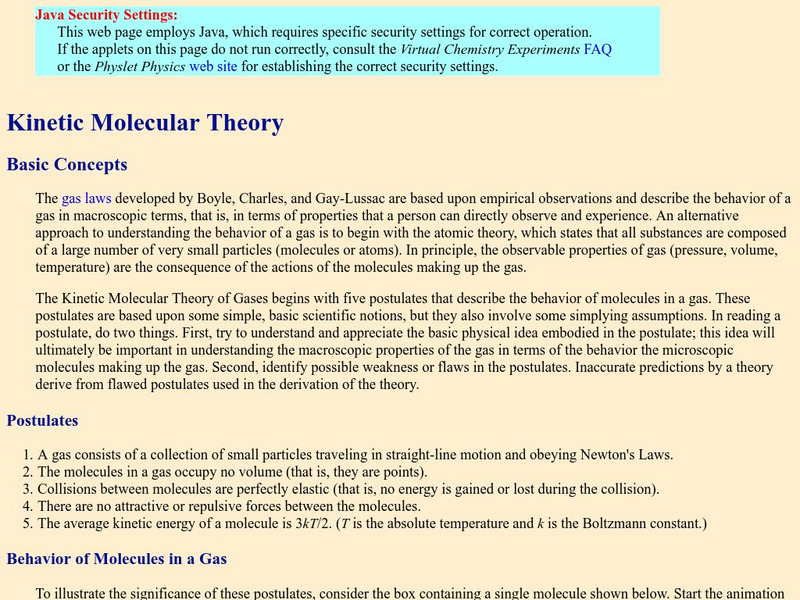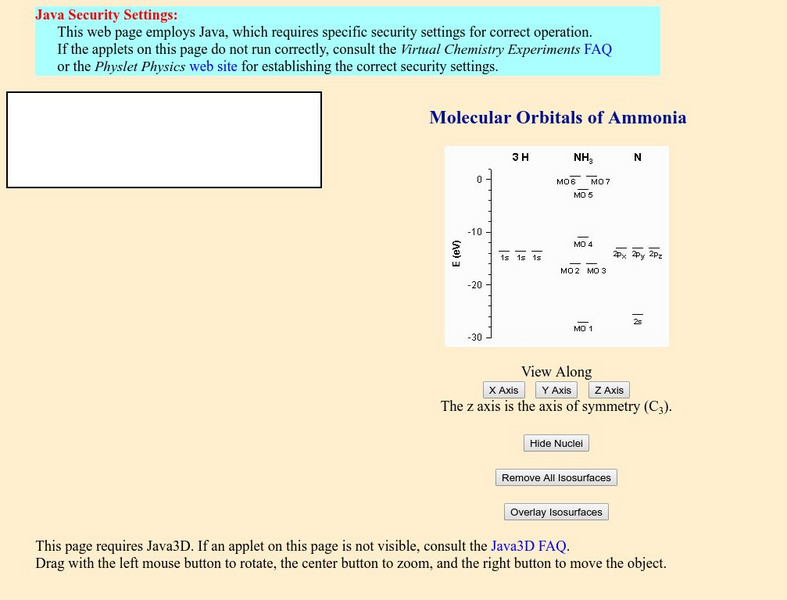Davidson College
Dna Microarray Methodology
Discover how DNA microarray experiments are conducted with this step-by-step tutorial.
Davidson College
Prima: Supreme Court's Response to Nativism in the 1920s
This article from a scholarly magazine from Davidson College outlines the legislation proposed and often passed that reflected nativist tenets, especially in state legislatures. Read how decisions of the Supreme Court found most of this...
Davidson College
Davidson College: Electronic Structure of Coordination Compounds
A list of five virtual chemistry topics with Java applets on the electronic structure of coordination compounds. Covers crystal field theory, CFT energy level splitting, color in gems, the spectrochemical series, and ligand properties.
Davidson College
Davidson College: Visualization of Atomic Orbitals: Hybrid Orbitals
Explains the creation of hybrid orbitals and presents their electron density plots and energy diagrams. Requires Java.
Davidson College
Davidson College: Chemical Kinetics: Integrated Rate Laws
Explains the integrated rate laws for zero-, first-, and second-order reactions. Students then try a virtual stopped-flow experiment to find the rate law and the rate constant for a chemical reaction. Requires Java.
Davidson College
Davidson College: Valence Shell Electron Pair Repulsion (Vsepr) Model
Presents examples of molecules that do not match the expected bond angles in the Valence-Shell Electron-Pair Repulsion Model. Requires Java.
Davidson College
Davidson College: Chemical Equilibria: Calculations With Reaction Stoichiometry
Explains the use of a reaction table when analyzing chemical equilibrium and presents a virtual experiment where the equilibrium constant of a chemical reaction is determined for different scenarios. Requires Java.
Davidson College
Electronegativity Tables
Collection of tables comparing the work of Pauling, Allred-Rochow, and Mulliken-Jaffe Scales. Taken from "Inorganic Chemistry" by Huheey, J.E.; Harper & Row: New York, 1983.
Davidson College
Davidson College: Le Chatelier's Principle Applet
This site includes an applet on Le Chatelier's principle. The applet allows the user to specify the initial amounts of carbon, water vapor, hydrogen gas, and carbon monoxide as well as the system temperature and volume. The applet will...
Davidson College
Physiology of Bioluminescence in Marine Animals
This physiology project page covers bioluminescence, how it works, what organisms are capable of it, and its purpose.
Davidson College
Davidson College: Hooke's Law
This site provides a java applet that lets you manipulate this experiment and evaluate the results. Good way to help you understand Hooke's Law of elasticity.
Davidson College
Davidson College: Network Solids: Crystalline Solids
Explains the differences between ionic, molecular, metallic, and network crystalline solids. Displays structures for diamond, graphite, fullerene, and silica, accompanied by questions about their chemical bonding. Electron density plots...
Davidson College
Davidson College: Chemical Equilibria
Explains what chemical equilibrium is and the role of the Law of Mass Action. A Java simulation shows the concentration-time curves of a chemical reaction.
Davidson College
Davidson College: Molecular Orbitals of Tetraamminecopper(ii)
A Java applet displays the Ligand Field Theory energy diagram for the Tetraamminecopper(II) ion. When an orbital in the diagram is clicked on, the isosurface is shown.
Davidson College
Davidson College: Sizes of Atomic Orbitals
Using a Java applet, sets of atomic orbitals are compared with different quantum numbers in order to compare the orbital sizes.
Davidson College
Davidson College: Visualization of Atomic Orbitals: P Orbitals
Discusses the geometry of the p orbitals and presents exercises for exploring their shape and orientations. Requires Java.
Davidson College
Davidson College: Visualization of Atomic Orbitals
Discusses the geometry of the d orbitals and presents exercises for exploring their shape and orientations. Requires Java.
Davidson College
Davidson College: Effective Nuclear Charge
Explains what Slater rules are and presents exercises for exploring how they are used to estimate the effective nuclear charge and how well they work compared to the Bohr model expression for orbital sizes. Requires Java.
Davidson College
Davidson College: Effective Nuclear Charge
Explains what the effective nuclear charge is and how electrons can create a shield between a nucleus and an outer electron. Presents exercises for comparing orbital sizes with effective nuclear charges. Requires Java.
Davidson College
Davidson College: Visualization of Atomic Orbitals: S Orbitals
Discusses the geometry of the s orbitals and presents exercises for exploring their shape and orientations. Requires Java.
Davidson College
Davidson College: Phase Changes: Phase Diagram: Part 5: Critical Point
Explains what the critical point in a phase change is and ways that a transition from a liquid to a gas can take place. Students investigate the concepts using a Java simulation.
Davidson College
Davidson College: Kinetic Molecular Theory: Basic Concepts
Discusses the basic concepts of kinetic molecular theory and presents animations illustrating the behavior of molecules in a closed box. Requires Java.
Davidson College
Davidson College: Valence Shell Electron Pair Repulsion (Vsepr) Model
Presents exercises where students can check their understanding of the Valence-Shell Electron-Pair Repulsion Model by predicting what a molecular shape will be. Requires Java.
Davidson College
Davidson College: Molecular Orbitals of Ammonia
A Java applet shows a molecular orbital representation of ammonia. When an orbital in the diagram is clicked on, the isosurface is shown. The orbitals for other molecules can be accessed through links at the bottom of the page.











